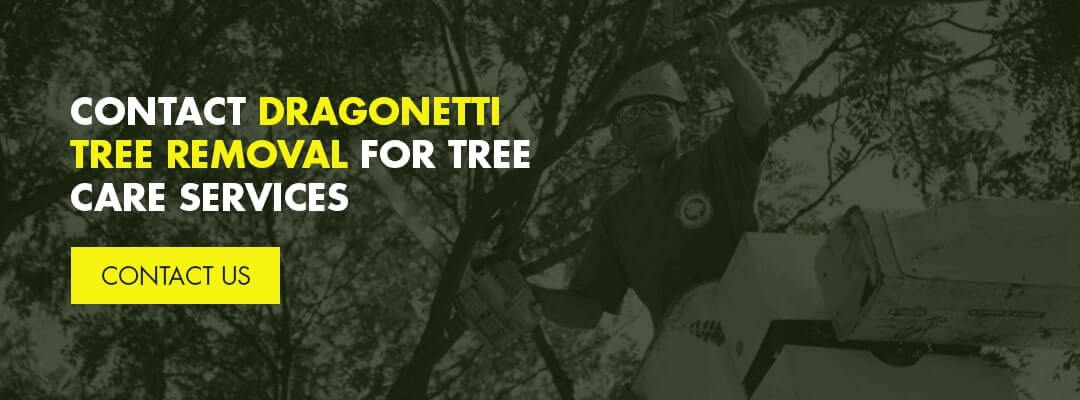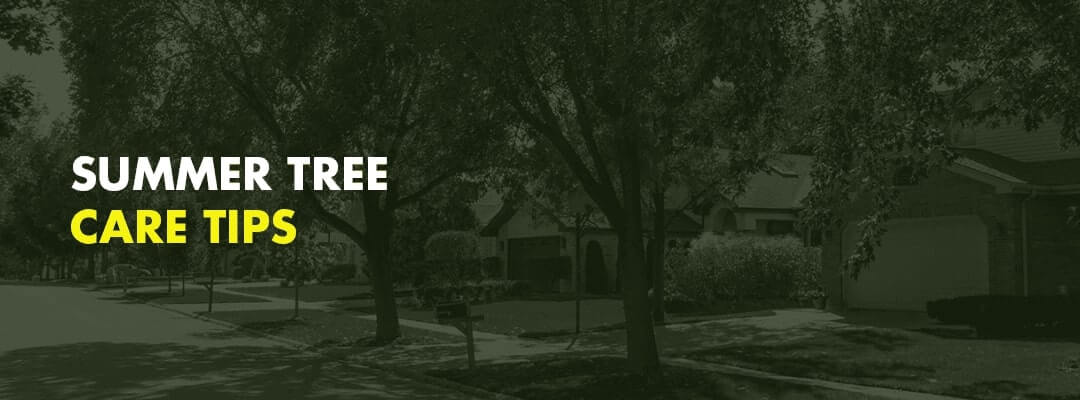
A tree in the summer is a beautiful thing to see, with its lush, green canopy of leaves. Trees provide much-needed shade in urban environments and let you get in touch with nature, even if you live in the middle of a city. Giving the trees around your property the right amount of care and attention throughout the summer months will ensure they continue to thrive and benefit you and your neighbors for as long as possible.
Follow these tips for summer tree care to keep the trees near your home vibrant and healthy for as long as possible.
GIVE THEM ENOUGH WATER
Trees, like all plants, animals and people, need water to survive. How much water you give them plays a significant role in their continued health, as does when and how frequently you water. A tree’s water needs will change over time, too. Water younger, freshly planted trees more frequently than older, more established trees. As a general rule of thumb, here’s how often you should water your trees, based on their planting.
- First two weeks after planting: Water daily.
- Up to 12 weeks after planting: Water every three days.
- After 12 weeks: Water weekly.
- After the tree has established itself: Water when the soil is dry to a depth of six inches.
How long it takes your tree’s roots to become established depends in large part on the tree’s size at planting. Generally, allow one and a half years for every inch in diameter of the trunk. A tree that measures an inch in diameter at planting will need a year and a half to establish itself. A 6-inch-diameter tree will need nine years to get fully established.
The amount of water your trees need at each watering depends on their size at planting, too. Larger trees need more water. A 6-inch tree needs between six and nine gallons of water, while a 1-inch tree needs one to 1.5 gallons at each watering. Established trees need considerably more water at each irrigation. Mature trees up to 10 inches in diameter need 10 gallons of water per inch of truck diameter. Established trees that measure more than 10 inches in diameter need 15 gallons of water per inch of trunk diameter.
HOW TO WATER TREES IN SUMMER
Proper watering is part of knowing how to care for trees in summer. You also want to pay attention to how you’re watering them. The goal is to avoid encouraging rot and strive to give the tree’s roots the moisture they need.
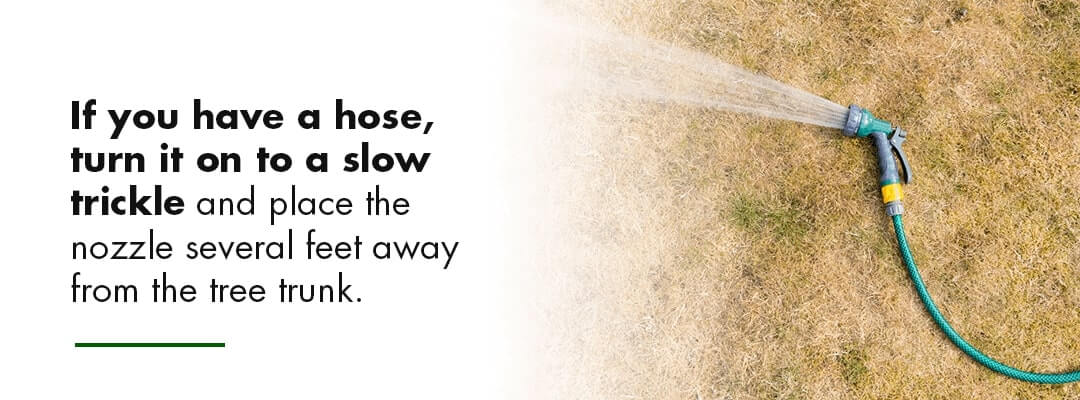
The best way to water trees in summer is slowly and deeply. If you have a hose, turn it on to a slow trickle and place the nozzle several feet away from the tree trunk. Let the hose run for about an hour, then move it several feet and repeat the process. Water around the dripline which is the distance the canopy extends out from the trunk. If you water too close to the trunk, there’s a chance it will rot.
You can also use a soaker hose to water your trees. Arrange the soaker hose in a circle around the tree, following the dripline. Water for at least one hour, or until the soil is wet for a depth of 6-9 inches.
TREE WATERING TIPS
Timing is crucial when watering your trees. Since the heat of the afternoon sun can evaporate any water you give the trees before the roots absorb it, it’s usually best to water in the early morning, before the sun is high in the sky, or the early evening, as the sun is setting.
You might want to create a watering schedule, but don’t get too attached to it. Instead, focus on the soil. It will let you know when your trees need more water. If the soil is wet and the calendar says it’s time to water, it’s better to skip watering that day. If the soil is parched and it’s not a scheduled watering day, give your trees a drink anyway.
ADD MULCH
One way to think about mulch is as a blanket that keeps your tree’s roots warm in the water and cool in the summer. Adding a layer of mulch around the tree’s base reduces evaporation, helping the tree’s roots get as much water as possible. When adding mulch around your trees, remember the following.
Keep the mulch away from the trunk: Leave several inches of space between the tree trunk and the start of the mulch. Piling mulch up against the tree’s trunk can contribute to rotting and give pests a place to hide.
Spread the mulch in an even thickness: Use enough mulch to provide adequate protection to the tree’s roots. Ideally, the layer of mulch will be between 3 and 5 inches thick.
Use enough mulch: Spread the mulch in a ring or doughnut shape that extends out to the dripline.
Skip over-mulching: Too much mulch makes your trees unhappy. A pile of mulch that’s thicker than 4 or 5 inches can overheat, harming your tree. Too much mulch also creates an ideal environment for bugs, rodents and microorganisms.
HOW TO CHOOSE MULCH
Mulch comes in many shapes and forms, from organic to inorganic. Dried grass, wood chips, sawdust, pine needles and composted manure are a few examples of organic mulch options. Rocks and gravel are two kinds of inorganic mulch.
The type of mulch you use around your trees depends largely on your aesthetic preferences and what you hope to do around the trees. Gravel mulch looks attractive, but isn’t ideal if you want to plant flowers around your trees. Organic mulch can break down over time, providing the soil with additional nutrients. Organic mulch is also appropriate if you plan on planting near your trees.
INSPECT YOUR TREES FOR PESTS AND DAMAGE
Pests such as beetles and caterpillars can cause significant damage to your trees. Some pests are native to New York, while others have made their way over here from far-flung destinations, such as Asia. Pests that arrive from other locations are usually invasive. They have few natural predators in New York and can proliferate.
A few examples of pests that damage trees in New York include:
- Tent caterpillars
- Asian long-horned beetles
- Gypsy moths
- Southern pine beetle
- Emerald ash borer
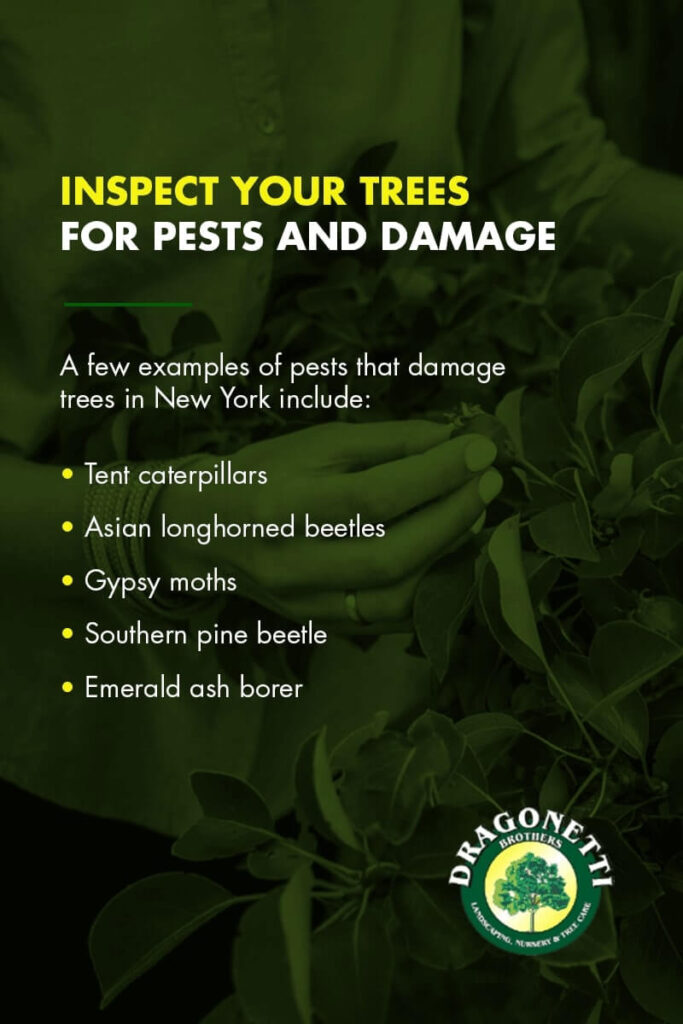
Some pests target just one or two species of tree. The southern pine beetle infests pine trees, while the Asian longhorned beetle attacks hardwoods, including birch and maple trees.
HOW TO IDENTIFY SIGNS OF PESTS
Knowing what to look for allows you to identify signs of pest damage in your trees, as different pests cause various types of damage.
Tent caterpillars and gypsy moths defoliate trees, meaning they eat the leaves of the tree. Caterpillars also create large webs, or “tents,” in the branches of the trees they infest. Usually, gypsy moths and tent caterpillars cause damage in the spring. They lay their eggs in the summer, though.
Tent caterpillar and gypsy moth egg masses are usually brown and look fuzzy, like a peach. If you see what you suspect to be egg masses on a hardwood tree, you can remove them by scraping them off the tree. Drop the egg masses into a bucket of detergent to kill the larvae inside. Wear gloves while doing so, as contact with the egg masses can irritate your skin. You might need to hire a professional or use a sprayer if egg masses cover a significant portion of the tree.
A trademark sign of an Asian longhorned beetle infestation is the presence of deep holes in the truck of a tree. The beetles lay eggs in the trees, creating depressions in the bark. After hatching, the larvae bore into the center of the tree, where they feed on the wood. Eventually, the larvae mature and make their way out of the tree, leaving exit holes that can be big enough for a pencil to fit inside.
The ash tree is one of the most commonly planted street trees in New York City. It’s also subject to damage from the emerald ash borer, an invasive species from Asia. Damage from the emerald ash borer causes leaves to die back and tree bark to fall off. Often, small tunnels are visible in the trunk of the tree where the bark has fallen away.
TRIM AND PRUNE YOUR TREES
Although winter and fall are usually the preferred times to prune trees, it sometimes makes sense to trim a tree in the summer. If you see dead branches on a tree, it’s usually better to cut them away than to leave them alone. Dead or damaged branches can fall off the tree in a storm, potentially causing harm.
Another reason to prune a tree in the summer is if it’s becoming overly large. Trimming a tree in the summer limits its growth in the next season. Usually, people want their trees to grow and thrive, so they wait until the tree isn’t in full leaf to prune. But if your goal is to rein in a tree, making a few cuts in the summer can be appropriate.
PREPARE YOUR TREES FOR STORMS
New York City sees its fair share of hurricanes and summer storms, and those storms can cause significant damage to trees. Tree bracing and cabling give trees a little extra support, helping them withstand the strong winds and lashing rains that often accompany the worst storms of summer.
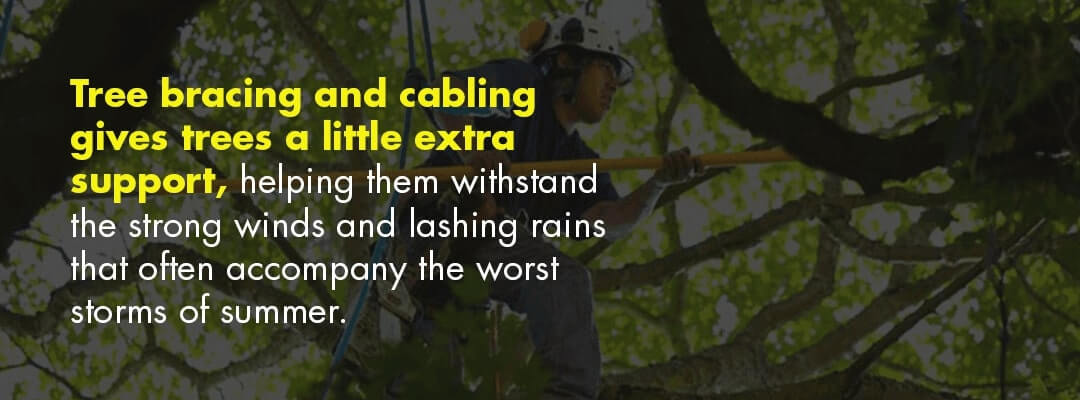
Tree cabling and bracing isn’t a project you can do yourself. Instead, you’ll want to hire an arborist to handle this for you. During cabling and bracing, the arborist attaches a cable to tree branches, creating an additional support system between the branches. The cable reduces the branches’ movement, making them less likely to flail about or break off in a storm.
Along with cabling and bracing your trees to prepare them for summer storms, an arborist might recommend pruning specific branches, such as those that look weak or hang over a house or other structure, to further reduce the risk of storm-related damage.
CONSIDER INJECTIONS
Like tree bracing and cabling, tree injections are something to consider if an arborist recommends them. Tree injections offer an alternative to spraying when you want to apply a pesticide such as a herbicide or an insecticide to a tree. One way to think about tree injections versus spraying is to compare them to the difference between getting a shot and applying a topical product to your skin. The shot, such as a flu vaccine, delivers the medicine directly into your body, while a topical cream remains on the surface. It washes off, and you need to reapply it frequently to get the most benefit from it.
Although injections can be preferable to spraying, they aren’t always the right choice for your trees. Drilling a hole into the trunk of the tree does create a wound. Depending on the tree’s age and condition, it might have difficulty healing. A certified arborist can help you decide if an injection is the best way to protect your trees, and if not, what alternatives are available.
FEED YOUR TREES
Your trees need to eat, especially if they are growing in an urban environment and face more stressors than trees that live in the woods or another natural environment. Fertilizing your trees provides them with the minerals and nutrients they need. In many cases, those minerals and nutrients might not naturally be in the soil the tree grows in. If your trees need fertilizer, they are likely to let you know. Look for small leaves, limited twig growth and unusual leaf color, such as yellow or light green.
It’s crucial to give your trees the right nutrients and minerals. One way to tell what your trees might need is to test the soil they grow in. You can send in a sample of the soil for lab analysis. The essential three nutrients trees and other plants usually need are nitrogen, phosphorus and potassium. Your tree might also need sulphur, magnesium or calcium, as well as micronutrients like zinc and iron.
CONTACT DRAGONETTI TREE REMOVAL FOR TREE CARE SERVICES
When you need professional assistance caring for trees in the summer, you can trust the experienced and knowledgeable arborists at Dragonetti Brothers Tree Removal. Our tree care services include trimming and PRUNING, tree cabling and bracing and tree removal. We can also offer guidance and advice on watering and fertilizing your trees to promote growth and enhance their health. Our tree services are available in Queens, Brooklyn and Manhattan.
Schedule your summer tree care services with Dragonetti Brothers Tree Removal today by calling (718) 451-1300. You can also contact us online for a free estimate.

